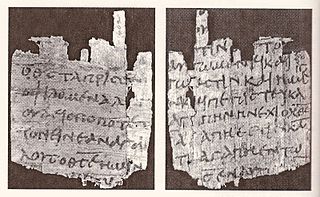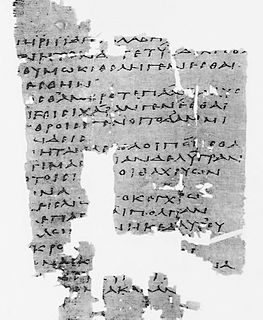
Sappho was an Archaic Greek poet from Eresos or Mytilene on the island of Lesbos. Sappho is known for her lyric poetry, written to be sung while accompanied by music. In ancient times, Sappho was widely regarded as one of the greatest lyric poets and was given names such as the "Tenth Muse" and "The Poetess". Most of Sappho's poetry is now lost, and what is extant has mostly survived in fragmentary form; only the "Ode to Aphrodite" is certainly complete. As well as lyric poetry, ancient commentators claimed that Sappho wrote elegiac and iambic poetry. Three epigrams attributed to Sappho are extant, but these are actually Hellenistic imitations of Sappho's style.

The Oxyrhynchus Papyri are a group of manuscripts discovered during the late nineteenth and early twentieth centuries by papyrologists Bernard Pyne Grenfell and Arthur Surridge Hunt at an ancient rubbish dump near Oxyrhynchus in Egypt.

Papyrus 9, signed by 9, and named Oxyrhynchus papyri 402, is an early copy of the New Testament in Greek. It is a papyrus manuscript of the First Epistle of John, dating paleographically to the early 3rd century.
Dirk D. Obbink is an American papyrologist and classicist. He was Lecturer in Papyrology and Greek Literature in the Faculty of Classics at Oxford University until 6 February 2021, and was the head of the Oxyrhynchus Papyri Project until August 2016. Obbink was also a fellow and tutor in Greek at Christ Church Oxford, from which role he was suspended in October 2019.

Papyrus Oxyrhynchus 7 is a papyrus found at Oxyrhynchus in Egypt. It was discovered by Bernard Pyne Grenfell and Arthur Surridge Hunt in 1897, and published in 1898. It dates to the third century AD. The papyrus is now in the British Library.
Papyrus Oxyrhynchus 46 is about a land distribution (καταλοχισμός), written by Phanias and Diogenes in Greek. It was discovered by Grenfell and Hunt in 1897 in Oxyrhynchus. The document was written on 30 January 100. It is housed in the Houghton Library of Harvard University. The text was published by Grenfell and Hunt in 1898.
Papyrus Oxyrhynchus 654 is a papyrus fragment of the logia of Jesus written in Greek. It is one of the Oxyrhynchus Papyri discovered by Grenfell and Hunt between 1897 and 1904 in the Egyptian town of Oxyrhynchus. The fragment is dated to the middle or late of the 3rd century. It is one of only three Greek manuscripts of the Gospel of Thomas.

Papyrus Oxyrhynchus 655 is a papyrus fragment of the logia of Jesus written in Greek. It is one of the Oxyrhynchus Papyri discovered by Grenfell and Hunt between 1897 and 1904 in the Egyptian town of Oxyrhynchus. The fragment is dated to the early 3rd century. It is one of only three Greek manuscripts of the Gospel of Thomas.

Sappho 16 is a fragment of a poem by the archaic Greek lyric poet Sappho. It is from Book I of the Alexandrian edition of Sappho's poetry, and is known from a second-century papyrus discovered at Oxyrhynchus in Egypt at the beginning of the twentieth century. Sappho 16 is a love poem – the genre for which Sappho was best known – which praises the beauty of the narrator's beloved, Anactoria, and expresses the speaker's desire for her now that she is absent. It makes the case that the most beautiful thing in the world is whatever one desires, using Helen of Troy's elopement with Paris as a mythological exemplum to support this argument. The poem is at least 20 lines long, though it is uncertain whether the poem ends at line 20 or continues for another stanza.

Fragment 44 is a fragment of a poem by the archaic Greek poet Sappho, which describes the wedding of Hector and Andromache. It is the longest of Sappho's surviving fragments, and is written in epic style suiting its subject.
Papyrus Oxyrhynchus 264 is a fragment of a sale of a loom, in Greek. It was discovered in Oxyrhynchus. The manuscript was written on papyrus in the form of a sheet. It is dated to 8 August 54. It is housed in the Cambridge University Library in Cambridge.
Papyrus Oxyrhynchus 298 is a fragment of a Letter of a Tax-Collector, in Greek. It was discovered in Oxyrhynchus. The manuscript was written on papyrus in the form of a sheet. It was written in the first century. Currently it is housed in the library of the Princeton University in Princeton.
Papyrus Oxyrhynchus 299 is a fragment of a Letter concerning a Mouse-Catcher, in Greek. It was discovered in Oxyrhynchus. The manuscript was written on papyrus in the form of a sheet. It was written in the late first century. Formerly it was held in the Bradfield College. The actual owner of the codex and place of its housing is unknown.
Papyrus Oxyrhynchus 300 is a fragment of a Letter to a Relative, in Greek. It was discovered in Oxyrhynchus. The manuscript was written on papyrus in the form of a sheet. It was written in the late first century. It is not known where the document was distributed. The actual owner of the codex and place of its housing is unknown.

The Ode to Aphrodite is a lyric poem by the archaic Greek poet Sappho, who wrote in the late seventh and early sixth centuries BCE, in which the speaker calls on the help of Aphrodite in the pursuit of a beloved. The poem – composed in Sapphic stanzas – survives in almost complete form, with only two places of uncertainty in the text. The seriousness with which Sappho intended the poem is disputed, though at least parts of the work appear to be intentionally humorous. The poem makes use of Homeric language, and alludes to episodes from the Iliad.

The Brothers Poem or Brothers Song is a series of lines of verse attributed to the archaic Greek poet Sappho, which had been lost since antiquity until being rediscovered in 2014. Most of its text, apart from its opening lines, survives. It is known only from a papyrus fragment, comprising one of a series of poems attributed to Sappho. It mentions two of her brothers, Charaxos and Larichos; the only known mention of their names in Sappho's writings, though they are known from other sources. These references, and aspects of the language and style, have been used to establish her authorship.

The Tithonus poem, also known as the old age poem or the New Sappho, is a poem by the archaic Greek poet Sappho. It is part of fragment 58 in Eva-Maria Voigt's edition of Sappho. The poem is from Book IV of the Alexandrian edition of Sappho's poetry. The poem was first published in 1922, after a fragment of papyrus on which it was partially preserved was discovered at Oxyrhynchus in Egypt. Papyrus fragments published in 2004 almost completed the poem, drawing international media attention. The poem is one of very few substantially complete works by Sappho, and deals with the effects of ageing. There is scholarly debate about where the poem ends, as four lines previously thought to have been part of the poem are not found on the 2004 papyrus.

Sappho 2 is a fragment of a poem by the archaic Greek lyric poet Sappho. In antiquity it was part of Book I of the Alexandrian edition of Sappho's poetry. Sixteen lines of the poem survive, preserved on a potsherd discovered in Egypt and first published in 1937 by Medea Norsa. It is in the form of a hymn to the goddess Aphrodite, summoning her to appear in a temple in an apple grove. The majority of the poem is made up of an extended description of the sacred grove to which Aphrodite is being summoned.
Papyrus Oxyrhynchus 581 is a papyrus fragment written in Ancient Greek, apparently recording the sale of a slave girl. Dating from 29 August 99 AD, P. Oxy. 581 was discovered, alongside hundreds of other papyri, by Bernard Pyne Grenfell and Arthur Surridge Hunt while excavating an ancient landfill at Oxyrhynchus in modern Egypt. The document's contents were published by the Egypt Exploration Fund in 1898, which also secured its donation to University College, Dundee, later the University of Dundee, in 1903 – where it still resides. Measuring 6.3 x 14.7 cm and consisting of 17 lines of text, the artifact represents the conclusion of a longer record, although the beginning of the papyrus was lost before it was found. P. Oxy. 581 has received a modest amount of scholarly attention, most recently and completely in a 2009 translation by classicist Amin Benaissa of Lady Margaret Hall, Oxford.
Papyrus Oxyrhynchus 1800 is a piece of a papyrus roll containing biographies of various mythical and historical figures from ancient Greece. The papyrus was discovered in 1905–06 as part of a large group of literary papyri, and is made up of 30 fragments. It is dated by the handwriting to the late second or early third century AD.











